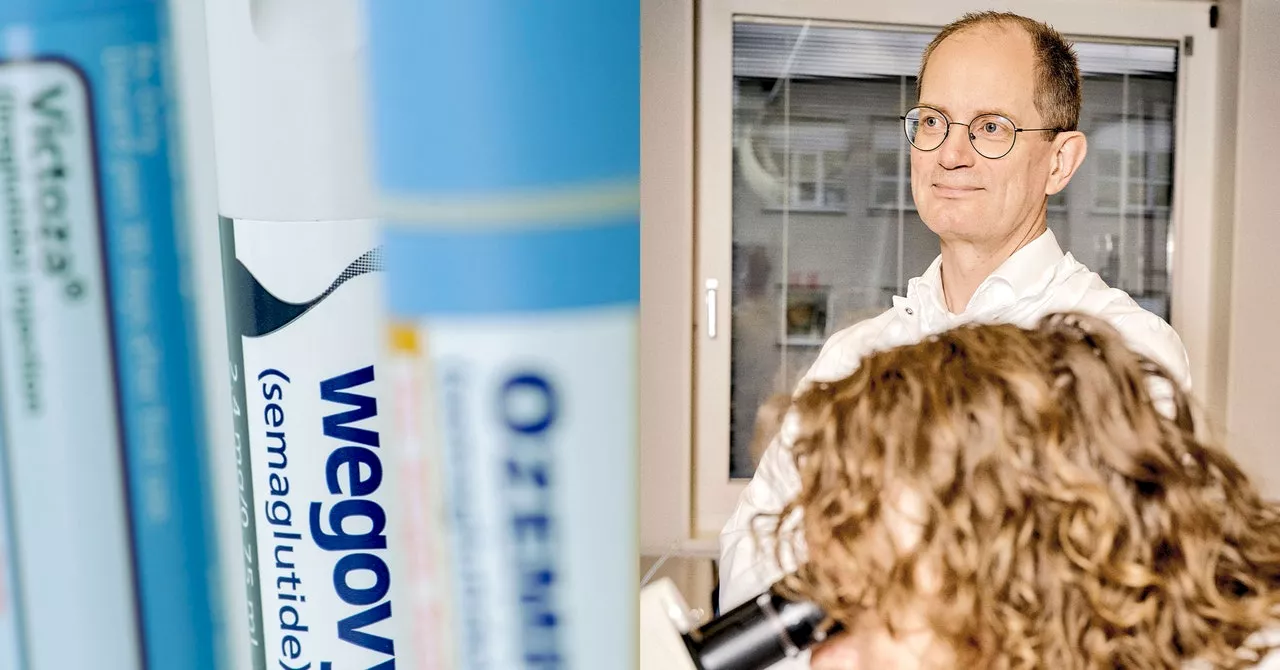This article explores the history of insulin and the rise of semaglutide, a drug that has revolutionized diabetes treatment and weight loss. It highlights the story of Erik Hageman, a man who survived childhood diabetes thanks to Hans Christian Hagedorn's pioneering work with insulin. The article also examines the ethical challenges facing Novo Nordisk, the company that produces both insulin and semaglutide, as it navigates the complex interplay of profit, patient care, and global health.
This was 1942. The Nazis occupied Denmark and eugenics was their first medical principle. Trauma like Erik’s fall, some suggested, activated diabetes, and the bloodline of the diabetic was poisoned. Three short weeks of neglect, the doctor promised Hageman’s parents, and their little son would perish of ketoacidosis or starvation. “The best you can do is do nothing,” the doctor said.
Still, Hageman’s parents felt—and this was rebellious, given the master-race ideology that crackled through the Nazi Weltanschauung—that their boy deserved to live. When Hageman’s father, a custodian at a sports college, told his coworkers his son had diabetes, one of them knew a guy. Hans Christian Hagedorn, short-tempered physician. Wild tufts of hair. At Nordisk Insulinlaboratorium just outside of Copenhagen, he was refining insulin from the pancreases of cows and pigs to make it work better for humans. During a long period under Hagedorn’s care, Erik Hageman started to get twice-daily injections of a fine precipitate of protamine insulin, a breakthrough formulation that prolonged insulin’s effects in the body. Neutral Protamine Hagedorn is still on the World Health Organization’s list of essential medicines. By the time he was 5, Hageman was injecting himself with a wide-gauge needle as broad as—he pantomimed to me, in a kind of diabetic fish story—a tree trunk. At 85, Erik Hageman is a dapper grandfather of surpassing warmth, compact like a tap dancer. He’s one of the longest-living diabetics in Denmark. We spent an afternoon together in a modernist mansion in Copenhagen called Domus Hagedorn, which is owned by Novo Nordisk, the Danish firm that grew from Hagedorn’s lab. “Hagedorn was rather crazy,” Hageman told me. But without the doctor’s care, he explained, “I’d be blind and I’d have to cut off my legs and have kidney failure.” The now-global company makes half the insulin in the world. Yet today it’s rich and famous for producing Ozempic, the megahit semaglutide drug.Just before visiting Erik Hageman, I met Lars Fruergaard Jørgensen, who has presided over the company’s epochal metamorphosis, at the company’s headquarters in Bagsværd, a suburb of Copenhagen. The building’s design, with its giant helix-like indoor spiral staircase, is inspired by insulin—the molecule, the miracle. In a conference room flooded with light, Jørgensen spoke fondly of Hageman, the company’s poster child. Novo’s executives had clearly presented Hageman to convince me that the company’s greatest achievement is not its stratospheric valuation but its century-long record of saving lives with insulin. But at Novo these days, semaglutide blocks out the sun. Ozempic was the world’s second-highest-selling drug in 2024. It works extremely well for type 2 diabetes, a non-autoimmune disorder in which the body makes poor use of insulin. And one effect of semaglutide, as we all know now, has been the box-office draw from day one: appetite suppression. The drugs that contain it—especially Ozempic and its more powerful sister Wegovy—have transformed Novo into a global slimming juggernaut. In 2023, the company surpassed Parisian luxury brand LVMH to become the richest company in all of Europe, hitting the ludicrously high market cap of $424 billion. In 2024, Novo took a punch in the face, but it ended the year still richer by market cap than Bank of America, Coca-Cola, and Toyota. Beyond the dazzling before-and-afters, though, Jørgensen is looking at a tricky future, parts of which, he told me, “scare the hell” out of him. Though Novo has as its controlling shareholder the largest altruistic foundation in the world, it has to act coldly and tactically, like an oil or defense company. The demanding semaglutide business has become a mean ouroboros: the insatiable market, exorbitant manufacturing costs, competition from Eli Lilly, pricing pressure from governments, and the private-insurance dystopia in the US—by far Novo’s biggest market, where some 15 million people now take semaglutide. At the same time is the moral crux. Semaglutide alone almost never works for the 8.4 million type 1 diabetics around the world. What keeps Jørgensen up at night is his fear that, the way drug manufacturing and American health care companies and global markets work, his company might not be able to do right by its original patients. These are the non-Hollywood patients—the ones who, like Eric Hageman, can’t live without insulin. GLP-1 can be seen as a tranquilizer for the flesh, a soother of deep and primitive longings. GLP-1 says to the body: peace. Food is available. But GLP-1 in its natural form only murmurs these soothing blandishments for a minute or two. It affords the hungry soul a glimpse of OK-ness, but a fleeting one. The challenge for Knudsen was to build a dupe of GLP-1 that would persist, a GLP-1 that would let a patient feel blood-sugar equanimity longer. Knudsen pulled this off by snapping a fatty acid onto a precise spot on a chain of amino acid
Health Business INSULIN SEMAGLUTIDE DIABETES NOVO NORDISK ETHICS WEIGHT LOSS DRUG DEVELOPMENT
United States Latest News, United States Headlines
Similar News:You can also read news stories similar to this one that we have collected from other news sources.
 Nature's instructions: How fungi make a key medicinal moleculeResearchers have decoded the genetic blueprint of Penicillium citrinum, a common citrus mold, to uncover how nature produces cyclopentachromone -- a key building block for bioactive compounds with potential in cancer and inflammation treatments.
Nature's instructions: How fungi make a key medicinal moleculeResearchers have decoded the genetic blueprint of Penicillium citrinum, a common citrus mold, to uncover how nature produces cyclopentachromone -- a key building block for bioactive compounds with potential in cancer and inflammation treatments.
Read more »
 New molecule-creation method a 'powerful tool' to accelerate drug synthesis and discoveryA team of chemists has unveiled a novel method to simplify the synthesis of piperidines, a key structural component in many pharmaceuticals. The study combines biocatalytic carbon-hydrogen oxidation and radical cross-coupling, offering a streamlined and cost-effective approach to create complex, three-dimensional molecules.
New molecule-creation method a 'powerful tool' to accelerate drug synthesis and discoveryA team of chemists has unveiled a novel method to simplify the synthesis of piperidines, a key structural component in many pharmaceuticals. The study combines biocatalytic carbon-hydrogen oxidation and radical cross-coupling, offering a streamlined and cost-effective approach to create complex, three-dimensional molecules.
Read more »
 LMU Researchers Develop Molecule to Control TRPM8 Ion Channels with LightResearchers at LMU Munich have developed a groundbreaking molecule called azo-menthol that allows precise control of TRPM8 ion channels using light. This discovery has significant therapeutic potential as TRPM8 channels are involved in various diseases, including cancer, metabolic disorders, and inflammation.
LMU Researchers Develop Molecule to Control TRPM8 Ion Channels with LightResearchers at LMU Munich have developed a groundbreaking molecule called azo-menthol that allows precise control of TRPM8 ion channels using light. This discovery has significant therapeutic potential as TRPM8 channels are involved in various diseases, including cancer, metabolic disorders, and inflammation.
Read more »
 Discovery of a Molecule with Dual Action: Healing Intestines and Suppressing CancerResearchers have identified a molecule called LXR that can promote intestinal tissue regeneration while simultaneously inhibiting tumor growth in colorectal cancer. This discovery could pave the way for more targeted treatments for both inflammatory bowel disease (IBD) and cancer.
Discovery of a Molecule with Dual Action: Healing Intestines and Suppressing CancerResearchers have identified a molecule called LXR that can promote intestinal tissue regeneration while simultaneously inhibiting tumor growth in colorectal cancer. This discovery could pave the way for more targeted treatments for both inflammatory bowel disease (IBD) and cancer.
Read more »
 Single-Molecule Sensor Could Revolutionize Disease DiagnosisUC Riverside scientists have developed a nanopore-based tool that can detect electrical signals from individual molecules, potentially enabling faster and more precise disease diagnosis compared to current methods.
Single-Molecule Sensor Could Revolutionize Disease DiagnosisUC Riverside scientists have developed a nanopore-based tool that can detect electrical signals from individual molecules, potentially enabling faster and more precise disease diagnosis compared to current methods.
Read more »
 AI Revolutionizes Drug Discovery: Insilico Medicine Uncovers Promising Molecule for IPFAI technology is transforming the way drugs are discovered, with Insilico Medicine leading the charge. Their AI-powered platform has identified a novel molecule for treating idiopathic pulmonary fibrosis (IPF), a rare and progressive lung disease. This breakthrough highlights the potential of AI to accelerate drug development and bring new treatments to patients.
AI Revolutionizes Drug Discovery: Insilico Medicine Uncovers Promising Molecule for IPFAI technology is transforming the way drugs are discovered, with Insilico Medicine leading the charge. Their AI-powered platform has identified a novel molecule for treating idiopathic pulmonary fibrosis (IPF), a rare and progressive lung disease. This breakthrough highlights the potential of AI to accelerate drug development and bring new treatments to patients.
Read more »
